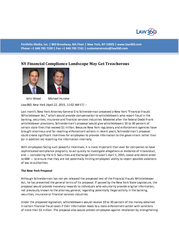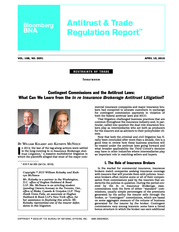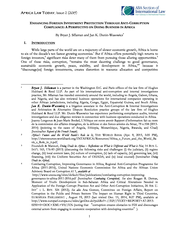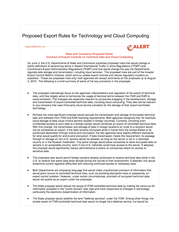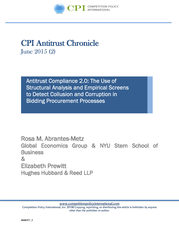Contingent Commissions and the Antitrust Laws: What Can We Learn from the In re Insurance Brokerage Antitrust Litigation? - April 2015
Hughes Hubbard & Reed
Description
6
agreements implies agreements among the insurers,
and second, that certain aspects of the alleged customer
steering schemes—particularly methods used to ensure
that business was placed with a certain insurer—
implied agreements among the insurers.52 The Third
Circuit rejected both arguments.
As to the nature of contingent commission agreements, the court noted that ‘‘each insurer had sound, independent business reasons to pay contingent commissions to become and remain a ‘preferred insurer.’ ’’53
The panel also considered that ‘‘plaintiffs’ argument
proves too much. If the parallel decisions by several insurers to pay contingent commissions imply a horizontal agreement, then it is difficult to see why parallel decisions to pay standard commissions . . .
would not also imply an agreement.’’54 As to the specific features of the alleged customer steering schemes, the court ruled that while the conduct alleged might give rise to claims under state law for deception or unfair trade practices, the allegations failed to state conduct prohibited by the Sherman Act.55 In the panel’s view, the alleged ‘‘incumbent protection racket,’’ including ‘‘first look’’ and ‘‘last look’’ bidding practices meant to ensure that a certain policy was placed or remained with a certain insurer, involved only practices that were vertical in nature (between the broker and the insurer), and ‘‘the complaints themselves provide[d] obvious reasons to conclude that the brokers were able to steer clients to preferred insurers without the need for any agreement among the insurers.’’56 For these reasons, the Third Circuit held that the plaintiffs had failed to state a claim of a per se violation of the Sherman Act with respect to their broad customer allocation claims tied to the payment of contingent commissions, and the claims were dismissed. The In re Insurance Brokerage plaintiffs had more success with their bid-rigging allegations—namely, that one Marsh entity, Marsh Global Broking, had conspired with a subset of the insurer defendants to rig bids by having those insurers submit false bids in order to direct business to certain insurers while maintaining a veneer of competition. The Third Circuit found that the willingness of the insurers involved in the specific incidents of bid-rigging alleged in the complaint to submit protective bids and actively assist in deceptive practices plausibly suggested collusion and horizontal agreements among those insurers not to compete for each other’s incumbent business.57 The court, therefore, reversed the district court with regard to these antitrust claims and remanded to the lower court for consideration of the sufficiency of those allegations under Rule 9(b) of the Federal Rules of Civil Procedure, which requires that allegations of fraudulent conduct be pleaded with particularity.58 52 Id. at 327. Id.
(quoting Brief of Appellees, supra note 5, at 38). 54 Id. at 328. 55 Id. at 334. 56 Id.
at 334–35. 57 Id. at 339–40, 347–48. 58 The District Court never spoke on the 9(b) issue, as the many parties settled between 2011 and 2013. 53 4-10-15 V. Ultimate Denouement After the remaining federal and state law claims were remanded to the district court, the plaintiffs in the consolidated class action and in various tag-along individual and class actions reached settlements with all of the remaining defendants while the claims in their complaint were still at the motion to dismiss stage.
The terms of the class action settlements are all public. Those terms indicate that the plaintiffs settled the remaining claims for a small fraction of the amounts of the settlements Attorney General Spitzer had earlier extracted from Marsh and some of the other major broker and insurer defendants or that the class action plaintiffs had extracted from those brokers and insurers who settled early in the litigation before the Third Circuit’s ruling.59 The Third Circuit’s opinion and the ensuing settlements provide two major takeaways for those practicing antitrust in the insurance industry. First, the opinion, along with the Blue Cross decision adopting the Third Circuit’s opinion, show that, in line with other exemptions from the antitrust laws, courts will construe the McCarran-Ferguson Act narrowly. Only those activities that meet the indicia set out in Pireno, or that fall within the specifically enumerated categories as described in Owens, will fall within its carve-out from the antitrust laws.
Consequently, those who have concerns about the antitrust implications of certain actions should be wary of depending on the shelter of the McCarran-Ferguson Act if they are not directly related to risk-spreading activities. Second, the In re Insurance Brokerage opinion should assuage concerns that contingent commission payments to insurance brokers via ‘‘preferred-partner’’ arrangements with insurance companies are per se anticompetitive. Although the Third Circuit opinion left open the possibility that such practices could be challenged under a ‘‘rule of reason’’ analysis, the settlement of the tag-along cases, several of which sought to allege rule of reason claims, at the motion to dismiss stage, and the growing acceptance of contingent commissions by state insurance regulators subject to a disclosure regime suggests that there is little room for actions challenging these vertical arrangements on a rule of reason theory either. The Third Circuit’s opinion suggests that these parallel vertical agreements—be they structured as contingent commissions or ‘‘preferred partner’’ agreements—will not fall afoul of antitrust laws without evidence of actual collusion among the insurers, or of other traditionally anticompetitive practices such as bid-rigging. 59 See In re Ins.
Brokerage Antitrust Litig., MDL No. 1663, Civ. No.
04-5184, 2009 WL 411877 (D.N.J. Feb. 17, 2009) (approving $69 million settlement with Marsh Defendants); In re Ins.
Brokerage Antitrust Litig., 579 F.3d 241, 248, 252, 254–55 (3d Cir. 2009) (affirming district court’s approvals of $121.8 million settlement with Zurich Defendants and $28 million settlement with Gallagher Defendants); In re Ins. Brokerage Antitrust Litig., 282 F.R.D.
92, 101, 118 (D.N.J. 2012) (approving $41 million Global Settlement with eleven of the fourteen defendants remaining after the Third Circuit’s decision); In re Ins. Brokerage Antitrust Litig., 297 F.R.D.
136, 143, 147 (D.N.J. 2013) (approving $10.5 million settlement resolving the consolidated class action as to the final three remaining defendants). COPYRIGHT ஽ 2015 BY THE BUREAU OF NATIONAL AFFAIRS, INC. ATRR ISSN 0003-6021 .
would not also imply an agreement.’’54 As to the specific features of the alleged customer steering schemes, the court ruled that while the conduct alleged might give rise to claims under state law for deception or unfair trade practices, the allegations failed to state conduct prohibited by the Sherman Act.55 In the panel’s view, the alleged ‘‘incumbent protection racket,’’ including ‘‘first look’’ and ‘‘last look’’ bidding practices meant to ensure that a certain policy was placed or remained with a certain insurer, involved only practices that were vertical in nature (between the broker and the insurer), and ‘‘the complaints themselves provide[d] obvious reasons to conclude that the brokers were able to steer clients to preferred insurers without the need for any agreement among the insurers.’’56 For these reasons, the Third Circuit held that the plaintiffs had failed to state a claim of a per se violation of the Sherman Act with respect to their broad customer allocation claims tied to the payment of contingent commissions, and the claims were dismissed. The In re Insurance Brokerage plaintiffs had more success with their bid-rigging allegations—namely, that one Marsh entity, Marsh Global Broking, had conspired with a subset of the insurer defendants to rig bids by having those insurers submit false bids in order to direct business to certain insurers while maintaining a veneer of competition. The Third Circuit found that the willingness of the insurers involved in the specific incidents of bid-rigging alleged in the complaint to submit protective bids and actively assist in deceptive practices plausibly suggested collusion and horizontal agreements among those insurers not to compete for each other’s incumbent business.57 The court, therefore, reversed the district court with regard to these antitrust claims and remanded to the lower court for consideration of the sufficiency of those allegations under Rule 9(b) of the Federal Rules of Civil Procedure, which requires that allegations of fraudulent conduct be pleaded with particularity.58 52 Id. at 327. Id.
(quoting Brief of Appellees, supra note 5, at 38). 54 Id. at 328. 55 Id. at 334. 56 Id.
at 334–35. 57 Id. at 339–40, 347–48. 58 The District Court never spoke on the 9(b) issue, as the many parties settled between 2011 and 2013. 53 4-10-15 V. Ultimate Denouement After the remaining federal and state law claims were remanded to the district court, the plaintiffs in the consolidated class action and in various tag-along individual and class actions reached settlements with all of the remaining defendants while the claims in their complaint were still at the motion to dismiss stage.
The terms of the class action settlements are all public. Those terms indicate that the plaintiffs settled the remaining claims for a small fraction of the amounts of the settlements Attorney General Spitzer had earlier extracted from Marsh and some of the other major broker and insurer defendants or that the class action plaintiffs had extracted from those brokers and insurers who settled early in the litigation before the Third Circuit’s ruling.59 The Third Circuit’s opinion and the ensuing settlements provide two major takeaways for those practicing antitrust in the insurance industry. First, the opinion, along with the Blue Cross decision adopting the Third Circuit’s opinion, show that, in line with other exemptions from the antitrust laws, courts will construe the McCarran-Ferguson Act narrowly. Only those activities that meet the indicia set out in Pireno, or that fall within the specifically enumerated categories as described in Owens, will fall within its carve-out from the antitrust laws.
Consequently, those who have concerns about the antitrust implications of certain actions should be wary of depending on the shelter of the McCarran-Ferguson Act if they are not directly related to risk-spreading activities. Second, the In re Insurance Brokerage opinion should assuage concerns that contingent commission payments to insurance brokers via ‘‘preferred-partner’’ arrangements with insurance companies are per se anticompetitive. Although the Third Circuit opinion left open the possibility that such practices could be challenged under a ‘‘rule of reason’’ analysis, the settlement of the tag-along cases, several of which sought to allege rule of reason claims, at the motion to dismiss stage, and the growing acceptance of contingent commissions by state insurance regulators subject to a disclosure regime suggests that there is little room for actions challenging these vertical arrangements on a rule of reason theory either. The Third Circuit’s opinion suggests that these parallel vertical agreements—be they structured as contingent commissions or ‘‘preferred partner’’ agreements—will not fall afoul of antitrust laws without evidence of actual collusion among the insurers, or of other traditionally anticompetitive practices such as bid-rigging. 59 See In re Ins.
Brokerage Antitrust Litig., MDL No. 1663, Civ. No.
04-5184, 2009 WL 411877 (D.N.J. Feb. 17, 2009) (approving $69 million settlement with Marsh Defendants); In re Ins.
Brokerage Antitrust Litig., 579 F.3d 241, 248, 252, 254–55 (3d Cir. 2009) (affirming district court’s approvals of $121.8 million settlement with Zurich Defendants and $28 million settlement with Gallagher Defendants); In re Ins. Brokerage Antitrust Litig., 282 F.R.D.
92, 101, 118 (D.N.J. 2012) (approving $41 million Global Settlement with eleven of the fourteen defendants remaining after the Third Circuit’s decision); In re Ins. Brokerage Antitrust Litig., 297 F.R.D.
136, 143, 147 (D.N.J. 2013) (approving $10.5 million settlement resolving the consolidated class action as to the final three remaining defendants). COPYRIGHT ஽ 2015 BY THE BUREAU OF NATIONAL AFFAIRS, INC. ATRR ISSN 0003-6021 .

